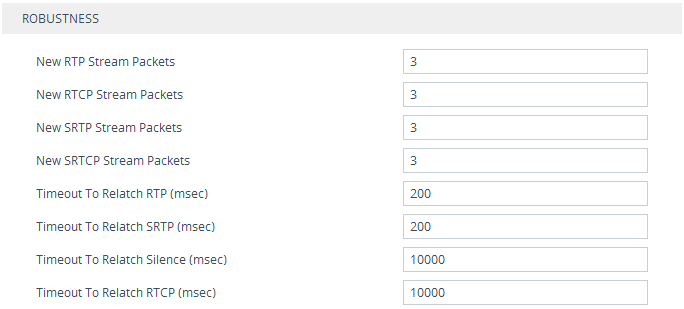Robust Receipt of Media Streams by Media Latching
The device's Robust Media feature (or media latching) filters out unwanted media (RTP, RTCP, SRTP, SRTCP, and T.38) streams that are sent to the same port number of the device. Media ports may receive additional multiple unwanted media streams (from multiple sources of traffic) as result of traces of previous calls, call control errors, or deliberate malicious attacks (e.g., Denial of Service). When the device receives more than one media stream on the same port, the Robust Media mechanism detects the valid media stream and ignores the rest. Thus, this can prevent an established call been stolen by a malicious attacker on the media stream.
For the involved voice channel, the device latches on to the first stream of the first received packet. All packets (of any media type) received from the same IP address and SSRC are accepted (for T.38 packets, the device considers only the IP address). If the channel receives subsequent packets from a non-latched source, the device can either ignore this new stream and remain latched to the first original stream (IP address:port) or it can latch on to this new stream. The media latch mode is configured using the InboundMediaLatchMode parameter. If this mode is configured to latch on to new streams, you also need to configure the following:
|
■
|
Minimum number of continuous media packets that need to be received from a different source(s) before the channel can latch onto this new incoming stream.
|
|
■
|
Period (msec) during which if no packets are received from the current stream, the channel latches onto the next packet received from any other stream.
|
Depending on media latch mode, if the device has latched on to a new stream and a packet from the original (first latched onto) IP address:port is received at any time, the device latches on to this original stream.
Latching on to a new T.38 stream is reported in CDR using the CDR fields, LatchedT38Ip (new IP address) and LatchedT38Port (new port). In addition, the SIP PUBLISH message updates the latched RTP SSRC, for example:
RemoteAddr: IP=10.33.2.55 Port=4000 SSRC=0x66d510ec
|
➢
|
To configure media latching:
|
|
1.
|
Open the Media Settings page (Setup menu > Signaling & Media tab > Media folder > Media Settings), and then from the 'Inbound Media Latch Mode' drop-down list (InboundMediaLatchMode), configure the media latch mode:
|

|
2.
|
If you configure Step 1 to Dynamic or Dynamic-Strict:
|
|
●
|
Configure the minimum number of continuous media (RTP, RTCP, SRTP, and SRTCP) packets that need to be received by the channel before it can latch onto this new incoming stream:
|
|
◆
|
'New RTP Stream Packets'
|
|
◆
|
'New RTCP Stream Packets'
|
|
◆
|
'New SRTP Stream Packets'
|
|
◆
|
'New SRTCP Stream Packets'
|
|
●
|
Configure a period (msec) after which if no packets are received from the current media session, the channel can re-latch onto another stream:
|
|
◆
|
'Timeout To Relatch RTP'
|
|
◆
|
'Timeout To Relatch SRTP'
|
|
◆
|
'Timeout To Relatch Silence'
|
|
◆
|
'Timeout To Relatch RTCP'
|
|
◆
|
'Fax Relay Rx/Tx Timeout'
|

|
3.
|
Click Apply, and then save your settings to flash memory.
|

